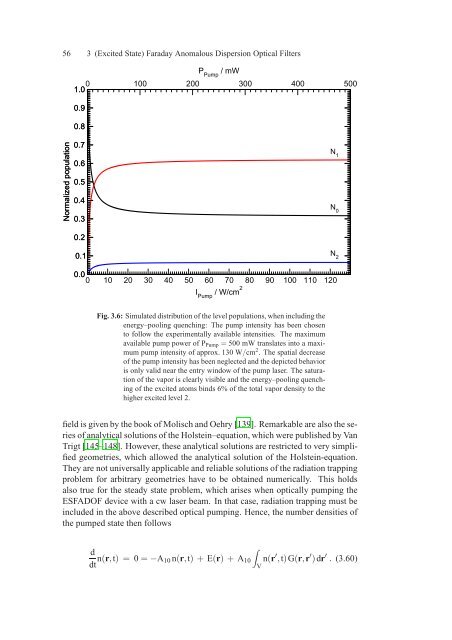Assessment of a Rubidium ESFADOF Edge-Filter as ... - tuprints
Assessment of a Rubidium ESFADOF Edge-Filter as ... - tuprints
Assessment of a Rubidium ESFADOF Edge-Filter as ... - tuprints
Create successful ePaper yourself
Turn your PDF publications into a flip-book with our unique Google optimized e-Paper software.
56 3 (Excited State) Faraday Anomalous Dispersion Optical <strong>Filter</strong>s<br />
P Pump<br />
/ mW<br />
0 1.0<br />
100 200 300 400 500<br />
0.9<br />
0.8<br />
Normalized population<br />
0.7<br />
0.6<br />
0.5<br />
0.4<br />
0.3<br />
0.2<br />
0.1<br />
N 1<br />
N 0<br />
N 2<br />
0.0<br />
0 10 20 30 40 50 60 70 80 90 100 110 120<br />
I Pump<br />
/ W/cm 2<br />
Fig. 3.6: Simulated distribution <strong>of</strong> the level populations, when including the<br />
energy–pooling quenching: The pump intensity h<strong>as</strong> been chosen<br />
to follow the experimentally available intensities. The maximum<br />
available pump power <strong>of</strong> P Pump = 500 mW translates into a maximum<br />
pump intensity <strong>of</strong> approx. 130 W/cm 2 . The spatial decre<strong>as</strong>e<br />
<strong>of</strong> the pump intensity h<strong>as</strong> been neglected and the depicted behavior<br />
is only valid near the entry window <strong>of</strong> the pump l<strong>as</strong>er. The saturation<br />
<strong>of</strong> the vapor is clearly visible and the energy–pooling quenching<br />
<strong>of</strong> the excited atoms binds 6% <strong>of</strong> the total vapor density to the<br />
higher excited level 2.<br />
field is given by the book <strong>of</strong> Molisch and Oehry [139]. Remarkable are also the series<br />
<strong>of</strong> analytical solutions <strong>of</strong> the Holstein–equation, which were published by Van<br />
Trigt [145–148]. However, these analytical solutions are restricted to very simplified<br />
geometries, which allowed the analytical solution <strong>of</strong> the Holstein-equation.<br />
They are not universally applicable and reliable solutions <strong>of</strong> the radiation trapping<br />
problem for arbitrary geometries have to be obtained numerically. This holds<br />
also true for the steady state problem, which arises when optically pumping the<br />
<strong>ESFADOF</strong> device with a cw l<strong>as</strong>er beam. In that c<strong>as</strong>e, radiation trapping must be<br />
included in the above described optical pumping. Hence, the number densities <strong>of</strong><br />
the pumped state then follows<br />
d<br />
dt n(r,t) = 0 = −A 10 n(r,t) + E(r) + A 10 n(r<br />
∫V<br />
′ ,t)G(r,r ′ )dr ′ . (3.60)
















